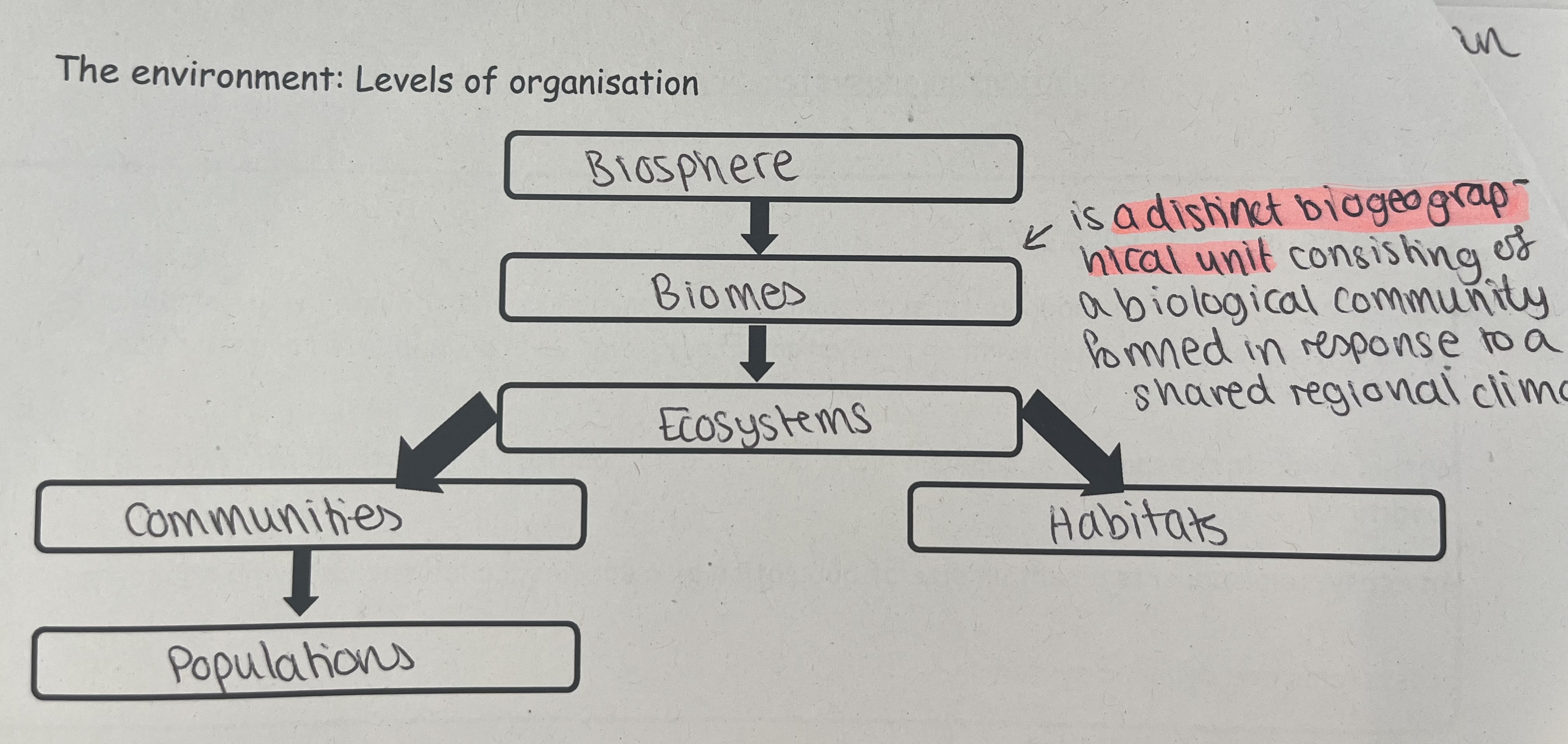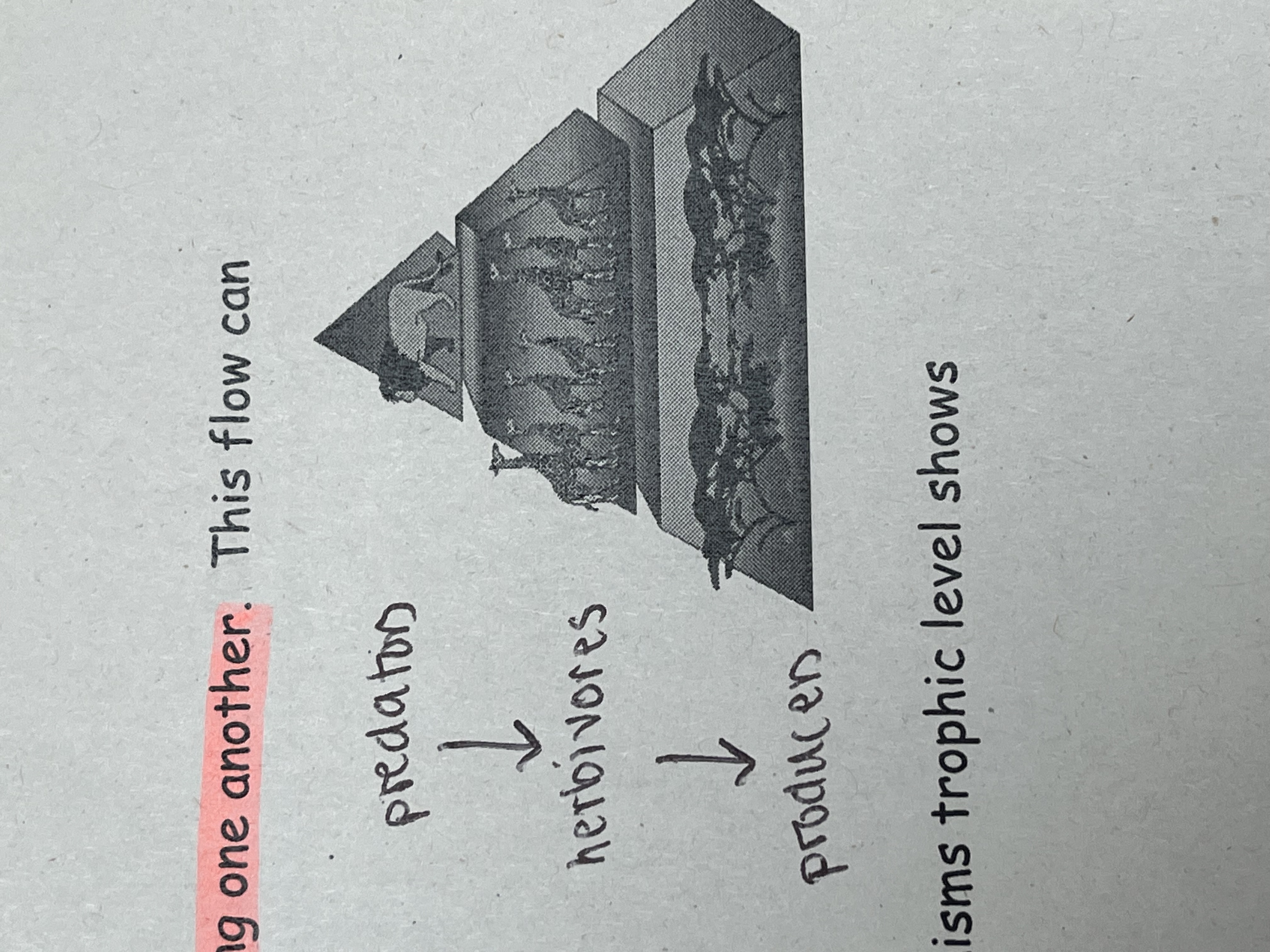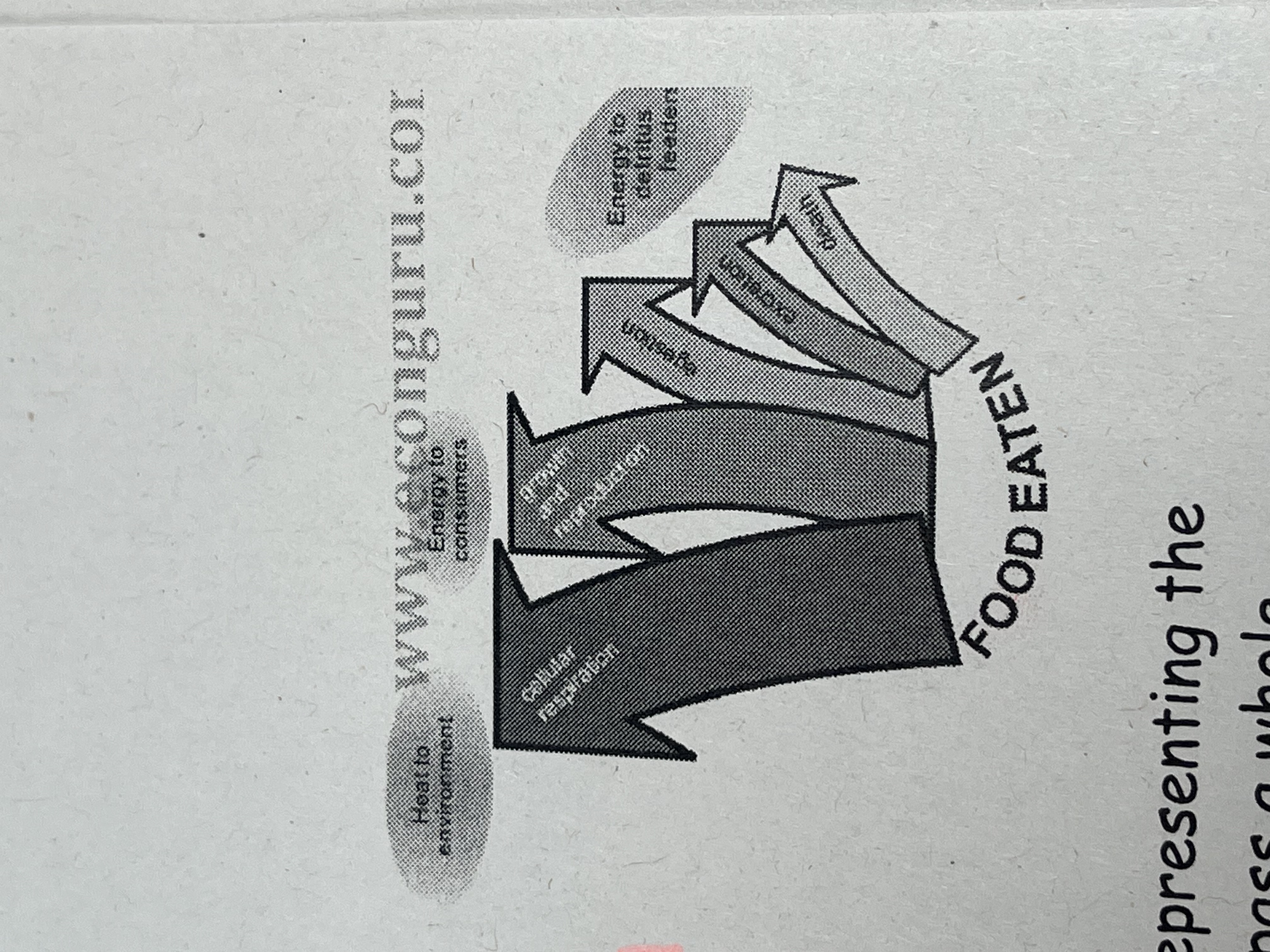ecology Y13
1/83
There's no tags or description
Looks like no tags are added yet.
Name | Mastery | Learn | Test | Matching | Spaced |
|---|
No study sessions yet.
84 Terms
What is ecology?
The study of the interrelationships between organisms and their environment
What are examples of abiotic factors?
temperature
Light
Water
Nutrients (nitrates and phosphates)
What are examples of biotic factors?
competition
Predation
Disease
What is the order of the levels of organization of the environment?

What is an ecosystem?
All the organisms living in a particular area and all the abiotic conditions found there
What is a habitat?
A place in the ecosystem inhabited by a population
What is a biome?
A major type of community
What is a biosphere?
All of the earth including all the ecosystems and communities
What is a community?
All the populations of all the different species living and interacting together in a habitat
What is a population?
The number of individuals of a species in a place
What is an ecological niche?
How an organism perfectly fits into its environment and what it needs for survival
What is carrying capacity?
The maximum stable population size of a species that an ecosystem can support
What is an indicator species?
Species that show the type of environment it is e.g a high oxygen environment
What is competition?
When two or more individuals share any resource that is insufficient to satisfy their requirements
What is intraspecific competition?
Form or competition where members of the same species need the same resource in an ecosystem
What is the result of less resources for species?
Lower birth rates and/ or higher mortality rates
What is interspecific competition?
A form of competition where different species need the same resource in an ecosystem
What does the competitive exclusion principle state?
Two species that use the same resource in the same way in the same space at the same time cannot coexist
What is a fundamental niche?
A niche that you would expect it to be
What is realised niche?
The species’ actual niche, which varies due to competition
Why do ecologists collect data?
To allow comparisons between communities and species e.g the abundance of organisms and their pattern of distribution and if this is influenced by abiotic or biotic factors
How do ecologists get a representative sample?
make sure sample size is large (40-50 quadrants)
What is a confounding variable?
An outside influence that changes the effect of a dependant and independent variable
When is a transect used?
Systematic sampling
for collecting data on immobile animals/ vegetation
Monitors how communities change along an environmental gradient
What are belt transects?
they study a wide strip across the area to be studied
Either used by placing quadrants continuously along a line (continuous belt transect)
Or placing quadrants at intervals (interrupted belt transect)
What are lone transects?
are quicker than belt transects
Samples on a point
Less informative than belt transect as it may miss many organisms
What are kite diagrams?
they represent the abundance of organisms along the transect
Larger width = larger abundance of organisms
What makes animal sampling difficult?
Fast moving organisms can escape, hide or move when approached, making them hard to find and identify
What are some examples of different approaches to battle this difficulty?
Sweep netting → involves collecting invertebrates using fine mesh netting
make sure same size net is used
Some species may escape and you have to euthanise captured species
Kick sampling → collecting fish using nets
sweep the net for the same amount of time each time
Doesn’t catch much fish as they swim away fast
Trapping → collects larger more mobile animals in terrestrial environments
Doesn’t give reliable data as it changes the environment and therefore the animals behaviour
Animals have to be euthanised to prevent predators killing insects
What is the mark-release- recapture method?
Animals are caught, marked and released back into the community and then recaptured later to find the estimated population
How is estimated population calculated?
(1st unmarked sample size x 2nd marked sample size) / number of marked animals recaptured in 2nd sample
What assumptions are relied on for this technique of sampling?
population doesn’t have immigration or emigration
Very few or no deaths and births between sampling
Non toxic, and non noticeable marking to predators
What is successsion?
The process of sequential change in community type overtime due to abiotic and biotic factors
What is the first stage of succession?
pioneer community
Pioneer plants (e.g lichen and moss) colonise the area first as they are tolerant to hostile conditions (e.g high salinity, large temp fluctuations)
What are lichens?
species that grow on Pavements, walls and tree bark in urban areas
Can tolerate high levels of pollution
Shrubby lichens indicate clean air
Flat lichens indicate pollution
What is marram grass?
colonise sand dunes and are xerophytes (tolerant of dry and sandy conditions)
Have thick outer cuticle and hairs to limit water loss
What do different pioneer species have in common?
can rapidly multiply due to asexual reproduction
Can photosynthesise in any light as long as there is some
Are tolerant to extreme conditions meaning they have less competition from other species
As succession continues…
Species diversity of the community increases and the food web becomes more complex
What is the species diversity index?
The number of species present and the abundance of them
What is the two types of succession?
Primary succession of a previously unoccupied area e.g lichen, marram grass
Secondary succession In altered habitats where some organisms are already present e.g cleared forests
What are the stages of succession?
Pioneer community - few species , susceptible to change , few interactions to populations
Sub climax community
Climax community - many species , resistant to change , many interactions between populations
Describe the process of succession.
Succession is the sequential change in a community over time, taking hundreds of years. Different species can withstand the biotic and abiotic factors in the dynamic environment. Pioneer plants are the first to colonise the area as species like lichen and moss can withstand the hostile environments. This is now known as a pioneer community. Overtime, these species decompose and provide a more suitable environment for other species to live in as they are adapted to it. This results in more habitats and higher biodiversity of species in the area, leading to a climax community which is stable.
What are producers?
Autotrophs that convert energy so other organisms can use it by photosynthesis which adds biomass to the area
What is biomass?
All the organic material in the ecosystem available to organisms
How do you measure biomass?
dessicate the organism and weigh their dry biomass
Use population estimates to scale up the biomass to the whole system
Units are gm^-2 when an area is being samples and gm^-3 when a volume is being sampled
How do you dry an organism?
open it up
Put in desiccating oven at around 100 degrees C
What does calorimetry calculate?
The amount of chemicals energy stored in an organisms dry biomass
What are the adaptations a calorimeter have to be more efficient?
a stirrer to make sure water flows over the sample all the time
Highly insulated so only the water is heated
What is primary productivity?
The rate at which plants convert inflight into chemical energy
Unit is kJm^-2year^-1
What is gross primary productivity?
The check energy store in plant biomass in a given area in a given time
What is net primary productivity?
The chemical energy store that is left after the plant loses energy to respiration
How do you calculate net primary production?
Net Primary Production = Gross Primary Productivity - Energy Used or Lost
(NPP = GPP - R)
What are consumers?
Heterotrophs that must eat other organisms for nutrition
What are consumers grouped into and what are they?
herbivores - eats producers
Carnivores - eats consumers
Omnivores - eats producers and consumers
Detritivores - eats wastes and part of dead consumers and producers
How can the energy flow from organisms eating one another in an ecosystem be represented?
ecological pyramids (tropic level diagrams or energy pyramids)
Food chains
Food webs

What is this type of ecological pyramid?
Trophic level diagrams

What type of ecological pyramids is this?
Energy pyramid
What do energy pyramids show?
How much energy is passed from one trophic level to the next (on average 10% energy transferred)
What is the difference between a food chain and a food web?
food chains are single pathways of energy transfer and a simple
Food webs are made of many interacting food chains and are more accurate as most organisms feed on and are eaten by more than one thing
How do you work out net production?
N = I - ( F + R )
I=chemical energy in ingested food
F= chemical energy lots in faeces and urine
R = energy lost through respiration
How do you work out percentage efficiency?
(Energy available after the transfer / energy available before the transfer) x 100
What does yield mean?
Amount of harvested material
What are the 4 main strategies used to improve efficiency of crop production?
fertiliser to maximise growth
Pesticides to minimise crop loss
Fungicides to prevent fungal infections
Herbicides to reduce competition from weed species
What are inorganic fertilisers?
NPK is the most commonly used one
Adds nitrate, phosphate and potassium ions in the soil to prevent limiting factor of not enough mineral ions available in soil
Are very effective as they have immediate effect
Are expensive
Due to it being soluble the ions are quickly leached out of the soil and into lakes and rivers causing environmental damage
What are organic fertilisers?
Animal manure and composted vegetable matter are examples of
They still contain NPK but in organic compounds such as urea and cellulose
These are digested by the soil organisms which release inorganic ions that the plants can take up in their roots
This causes less harm to environment
What are pesticides?
kill or reduce the population of organisms damaging crops by slowing growth or preventing reproduction
Pesticides must have no effect on the crop but effective against the pest
Multiple different chemicals can be used on the same plant
However use of pesticides can cause persistence (remains toxic for long time) and bio accumulation (doses of pesticides transferred to predator organism when they eat their pray, stored in fatty tissues)
What are herbicides?
kill off competing plant species
Broad spectrum herbicides kill of ALL plant species and can only be used PRIOR to sowing the crop plant
Selective herbicides affect CERTAIN types of plants only and can be applied WHILST the crop grows
How can simplifying the food chain increase the efficiency of animal production?
only consuming primary consumers minimised the energy lost to surrounding due to fewer trophic levels between producers and top consumer (humans)
How can reducing the energy lost through respiration increase the efficiency of animal production?
keeping animals in pens restricts movement.
Indoor pens means less energy is used to maintain body temperature
This means a greater proportion of the energy consumed in food is transferred into biomass and less is lost as heat energy to the surroundings (REMEMBER)
How can reducing other losses increase the efficiency of animal production?
giving animals more digestible freed reduces energy lost in faeces
This means a greater proportion of the energy in the food is used to ass biomass and less in faeces
What is nutrient cycling?
The cycle of simple organic molecules transferred into complex organic molecules
How are nutrients cycled?
nutrient taken up by producer which transfers it into a complex organic molecule (e.g amino acid, protein)
Elements from the nutrients pass into the consumers
Complex molecules hydrolysed when producers and consumers die, releasing simple inorganic molecules (e.g CO2 , N2 , H2O)
What are the two groups of decomposers?
detritivores (e.g worms)
Saprobiotic organisms (e.g bacteria)
What are detritivores?
Animals that digest lots of the solid materials but can’t digest cellulose or lignin
They increase the SA:VOL ratio of dead matter, making decomposition more efficient
What are saprobiotic organisms?
They use extra cellular digestion to carry out decomposing by breaking down cellulose/ lignin into soluble nutrients that they can absorb
they release co2 and h2o as a product of this
How can detritivores have a positive effect on saprobiotic organisms?
Worms burrowing in the soil maintains anaerobic conditions for the saprobiotics
What are mycorrhizae?
fungi that are long thing strands called hyphae connected to plant roots to increase their surface area so the plants can absorb scarce ions from soil
What is nitrogen fixation?
Nitrogen fixing bacteria that live in the nodules in the roots of some plants that reduces nitrogen gas to ammonia
What is nitrification?
Nitrifying bacteria that oxidises ammonia into nitrite ions then into nitrate ions
What is denitrification?
Anaerobic denitrifying bacteria that converts nitrate into nitrogen gas and nitrogen oxides that is then lost to the air, meaning they are inaccessible to plants
commonly associated with flooded ground where all aerobic processes stop
This can be tackled by adding drainage
What is ammonification?
Microbial saprophytes that break down proteins in dead material to form ammonia by digesting proteins into amino acids using protease and then removing the amino groups from the amino acids using deaminase
Why is phosphorous important for plants and animals?
Because it is used to make biological molecules such as DNA, ATP and phospholipids
Where is phosphate found?
In rocks
Dissolved in oceans in the form of phosphate ions
What are the 8 steps involved in the phosphorous cycle?
Phosphate ions released from rocks by weathering
Phosphate ions taking into plants via the roots → hyphae increases the rate of this as it makes the roots SA larger
Phosphate passed through food chains as organisms containing phosphate are eaten
Phosphate ions lost in faeces and urine
Saprobiotic organisms hydrolyse organic compounds in dead plants and animals, releasing phosphate into soil
Weathering of rock released phosphates into aquatic environments
Primary producers containing phosphate are eaten, passing phosphate through aquatic food chains
Phosphate ions lost to soils through Guano (accumulated bird faeces)